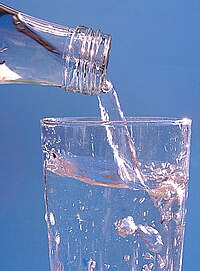
Photo from wikipedia
BACKGROUND Until now, the majority of methods employed to assess grapevine water status have been destructive, time-intensive, costly and provide information of a limited number of samples, thus the ability… Click to show full abstract
BACKGROUND Until now, the majority of methods employed to assess grapevine water status have been destructive, time-intensive, costly and provide information of a limited number of samples, thus the ability of revealing within-field water status variability is reduced. The goal of this work was to evaluate the capability of non-invasive, portable near infrared (NIR) spectroscopy acquired in the field, to assess the grapevine water status in diverse varieties, grown under different environmental conditions, in a fast and reliable way. The research was conducted 2 weeks before harvest in 2012, in two commercial vineyards, planted with eight different varieties. Spectral measurements were acquired in the field on the adaxial and abaxial sides of 160 individual leaves (20 leaves per variety) using a commercially available handheld spectrophotometer (1600-2400 nm). RESULTS Principal component analysis (PCA) and modified partial least squares (MPLS) were used to interpret the spectra and to develop reliable prediction models for stem water potential (Ψs ) (cross-validation correlation coefficient (rcv ) ranged from 0.77 to 0.93, and standard error of cross validation (SECV) ranged from 0.10 to 0.23), and leaf relative water content (RWC) (rcv ranged from 0.66 to 0.81, and SECV between 1.93 and 3.20). The performance differences between models built from abaxial and adaxial-acquired spectra is also discussed. CONCLUSIONS The capability of non-invasive NIR spectroscopy to reliably assess the grapevine water status under field conditions was proved. This technique can be a suitable and promising tool to appraise within-field variability of plant water status, helpful to define optimised irrigation strategies in the wine industry. © 2017 Society of Chemical Industry.
Journal Title: Journal of the science of food and agriculture
Year Published: 2017
Link to full text (if available)
Share on Social Media: Sign Up to like & get
recommendations!